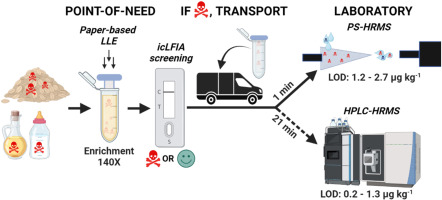The FoodSafeR consortium is proud to spotlight a new scientific advancement led by Ids Lemmink of Wageningen University & Research, a key partner in our Horizon Europe project.
Published in Analytica Chimica Acta, this innovative study introduces a highly sensitive and cost-effective workflow for detecting plant toxins in complex food matrices such as baby cereals, canola oil, and buckwheat cereals. The method combines paper-immobilized liquid-phase microextraction (PI-LPME) with paper-spray mass spectrometry, offering both portability and laboratory-grade precision.
One of the notable strengths of this approach is its dual functionality:
-
First, a point-of-need screening using lateral flow immunoassays enables rapid, on-site evaluation.
-
If a positive result is obtained, a second paper substrate can be transported for confirmatory analysis via paper-spray mass spectrometry, ensuring high sensitivity and reliability in detecting harmful plant toxins.
This research exemplifies the core values of FoodSafeR: practical innovation, scientific excellence, and risk-targeted tools that can be adapted across the food safety landscape. Particularly in products aimed at vulnerable populations, such as infant foods, early detection of plant-based toxins is crucial to preventing exposure and safeguarding public health.
The publication also highlights the exceptional collaborative work across our consortium, including contributions from Sipke Bosma, Gert Salentijn, Han Zuilhof, and Toine Bovee.
We invite you to read the full article to explore the methodology and findings in detail: Read the publication in Analytica Chimica Acta
This breakthrough is yet another example of how FoodSafeR is supporting scientific innovation to build a more responsive, resilient, and reliable food safety system across Europe.

